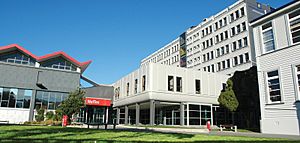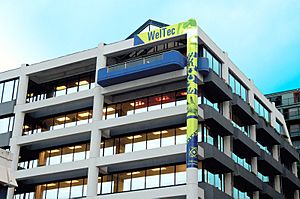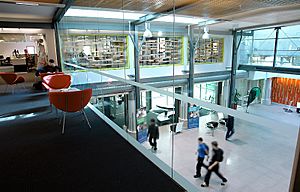Wellington Institute of Technology facts for kids
|
Te Whare Wānanga o te Awakairangi
|
|

View of the WelTec Petone student hub from the rear entrance.
|
|
|
Other name
|
WelTec |
|---|---|
| Motto |
Māori: Te ako ngātahi. Te whakaahua kētanga o te tangata.
|
|
Motto in English
|
Learning together. Transforming lives. |
| Type | Public |
| Established | 2001; 25 years ago (as WelTec) |
| Chief Executive | Mark Oldershaw |
|
Academic staff
|
229 (as of 2017) |
|
Administrative staff
|
35 (as of 2017) |
| Students | 3746 full-time students (as of 2017) |
| Undergraduates | 2000 (as of 2017) |
| Postgraduates | 325 (as of 2017) |
| Location | , , |
| Campus | Multiple |
| Colours | |
| Affiliations | Public NZ TEI |
 |
|
The Wellington Institute of Technology, also known as WelTec, is a special type of college in New Zealand. It's called a polytechnic and is located in Petone, Lower Hutt. WelTec was created in 2001. It was formed when two older colleges, the Central Institute of Technology (started in 1960) and the Hutt Valley Polytechnic (started in 1904), joined together.
In 2020, WelTec became part of a bigger group called the New Zealand Institute of Skills & Technology. This group includes many polytechnics across the country. WelTec helps about 8,000 students each year learn skills for jobs. It offers more than 130 different courses. These courses cover many areas like cooking, business, computers, art, and building.
Contents
WelTec's Journey: A History
Early Years: Petone Technical School (1904–1960)
WelTec started way back in 1904. It was first known as the Petone Technical School. At first, it was in rented buildings. In 1908, the school moved to its current main location in Petone. This is on Kensington Avenue.
Over the years, the school changed its name several times. Some of its past names include Petone Technical College and Hutt Valley Polytechnic.
Central Institute of Technology (1960–2000)
Starting the Central Institute of Technology
The Central Institute of Technology (CIT) was another polytechnic. It began in 1960. It was first called the Central Technical College. In 1963, its name changed to CIT. This college was first based at the Petone Technical College.
Building a new campus in Heretaunga started in 1970. The college then moved to this new campus in different stages. The first part, with science and engineering rooms, opened in 1973. The Prime Minister at the time, Norman Kirk, opened it.
New Buildings and Student Life
The second part of the Heretaunga campus opened in 1978. This included a seven-story dorm building. It could house up to 500 students. It also had training areas for hotel management courses. The third stage added a library and a TV production studio. It also had computer training rooms.
The final stage added facilities for health science courses. As new buildings were ready in Heretaunga, courses moved from Petone.
Changes in Health Courses
In 1989, some health training classes were moved. Pharmacy training moved to the University of Otago. Occupational therapy training moved to Auckland. Later that year, the health sciences school moved to Wellington Polytechnic. This was to be closer to the hospital.
Campus Improvements
In 1992, a podiatry school opened at CIT. Podiatry is about foot health. An aerobics center also opened to the public that year. In 1993, the podiatry school got a big upgrade. It added modern surgical rooms and X-ray facilities. A new lecture theatre was also built. It had full media equipment.
By 1994, Victoria University of Wellington was also offering courses at the CIT campus.
More Students at CIT
In 1995, the number of students at CIT grew a lot. The average student age went up from 19 to 31. More than half of the students were now female. The number of Māori students also increased. The total number of students grew by 26 percent.
Opening a Wellington Campus
In 1995, CIT leased a building in Wellington. This became their Wellington campus. It was called "CIT House." This campus offered computer science and business courses. Some of these computer courses were even used by NASA for staff training.
In 1996, CIT started offering bachelor's degrees. These included degrees in business information and tourism.
Talks about Joining Other Colleges
There were talks about CIT joining with other polytechnics. One idea was to merge with the Auckland Institute of Technology. This merger was later stopped in 1998. Another idea was to merge with Waikato Polytechnic. CIT had campuses in Auckland, Hamilton, and Wellington. But CIT decided not to go ahead with this merger either.
WelTec is Formed (2000–2010)
In 2000, it was announced that Hutt Valley Polytechnic and the Central Institute of Technology would merge. The new college would be called the Wellington Institute of Technology, or WelTec. Many courses would be held at the Petone campus. This was because most students lived closer to Petone.
The Heretaunga campus closed in June 2001. This was because fewer students were going there. Some of CIT's courses moved to other colleges. For example, podiatry went to the Auckland University of Technology. The Heretaunga campus building was later sold.
In 2005, WelTec opened its Church St campus. This was in a building that used to belong to a company called PricewaterhouseCoopers.
Working with Whitireia (2011–2019)
In 2011, WelTec and Whitireia Community Polytechnic decided to work together. They kept their own names but shared a single governing council. This new council started in 2012.
Over the next few years, they discussed joining their names and identities. In 2018, the government gave money to help colleges like WelTec and Whitireia. A special leader was appointed to help them. In 2019, WelTec and Whitireia announced they would reduce some jobs.
Becoming Part of NZIST (2020–Present)
On April 1, 2020, WelTec became part of the New Zealand Institute of Skills & Technology (NZIST). This big change included 15 other colleges. WelTec and the other colleges are now like branches of NZIST. On the same day, Mark Oldershaw became the new Chief Executive of both WelTec and Whitireia.
Campuses and Facilities
WelTec Campuses
Auckland Campus
The Auckland campus is on Queen Street in the center of Auckland. It focuses on social services. This includes helping young people grow and develop.
Petone Campus
Petone is the main campus. It is on Kensington Avenue in Lower Hutt. This campus has the main offices and a learning commons. The learning commons is like a library. It also has the Student Hub. Many different buildings on this campus are used for various courses.
Wellington Campus
The Wellington campus is on Dixon Street in the center of Wellington. WelTec shares this campus with Whitireia. It is also home to the Wellington ICT Graduate School. This campus focuses on business courses. Before 2017, this campus was on Church Street in Wellington.
Wellington School of Construction
This campus is next to the Petone railway station. It is on State Highway 2. It opened in 2015. This school teaches carpentry, painting, and decorating. The campus is very large, covering over 9,600 square meters. This means students have space to work on building up to six houses.
Wellington School of Hospitality
This campus is on Cuba Street in the center of Wellington. It opened in 2015 and cost $11 million to build. This school teaches hospitality skills. It has its own learning area. It also has a training restaurant called Bistro 52. There is also a training café called Latte Lab. Both are open to the public.
WelTec Facilities for Students
Cafes and Restaurants
WelTec has cafes and restaurants at most of its campuses. The Petone campus has a cafeteria for students and staff. At the Cuba Street campus, Bistro 52 restaurant and Latte Lab café are open to everyone.
Childcare Services
WelTec offers a childcare center called Te Whare Ako. Parents who are studying at the campus can use this service for their children.
Free Bus Service
WelTec and Whitireia offer a free bus service. It runs between the Petone, Wellington, and Porirua campuses. The bus runs on weekdays. It is free for all staff and students.
Hair and Beauty Salons
WelTec has professional salons. Here, students can practice their skills on real clients. These salons usually operate from June to October. You can find salons at both the Petone and Cuba Street campuses.
Prayer Rooms
WelTec has prayer rooms at two campuses: Petone and Cuba Street. These rooms offer a quiet and safe space for students and staff to pray.
Learning Commons
WelTec has three learning commons areas. These are at the Auckland, Petone, and Wellington Cuba Street campuses. Students can use these spaces to work on assignments. They can use computers and get help from staff. They can also access other WelTec services and resources.




